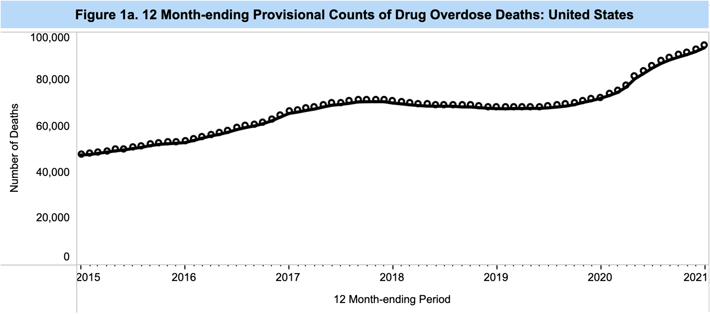Are Drug and Alcohol Addiction Fatalities the Next American Epidemic?

The Centers for Disease Control and Prevention reported that, in the year 2020, just under 94,000 Americans died from drug overdose deaths, the highest death toll ever reported since recording began. Not only is that death rate the highest ever, but it also represents the highest year-over-year jump in deaths, with 2020’s death toll being a 30% increase over drug-related deaths in 2019. Most of the surge in deaths was driven by a 55% increase in synthetic opioid overdose deaths, mainly fentanyl-related, though deaths from other drugs increased as well.
Meanwhile, also in 2020, the National Institute on Alcohol Abuse and Alcoholism revised its figures on annual alcohol-related deaths, increasing the estimated number to 95,000 deaths per year. Annual death rates for alcohol had been around 88,000 before 2020.
To put it plainly, close to 200,000 Americans are dying every year from drug and alcohol addiction, which comes out to over 500 deaths per day. Imagine if a mid-sized American city were wiped off the map every year. That’s exactly what is happening with drug and alcohol-related deaths. The U.S. is losing the entire population of a mid-sized American every year.
Though the statistics are gloomy to be sure, now more than ever the American people must understand that they are living through an addiction epidemic with drugs and alcohol. This isn’t just the next American epidemic; it is an epidemic occurring right now, today. And though that grim truth might lend itself to misery and pessimism, American families have to come together and help their loved ones who may be struggling with addiction. Addiction deaths are 100% preventable. Americans can win through this and survive the crisis through the use of qualified treatment programs and dedicated recovery efforts.
The Scope of Drug Addiction in America

Drug addiction is defined as a condition where a person has either a physical, psychological, or emotional dependence on a substance. With some addictions, all of these dependencies can be present. And with most addictions, the individual will experience withdrawal symptoms if they attempt to stop using the substance that they’re addicted to. The keynote to addiction is that the person has no control over their use of the substance, despite the fact that the substance has a harmful, detrimental effect on their lives and the lives of those around them.
Throughout the 21st century, drug addiction has soared among the American people. Primarily fueled by the opioid crisis but not limited to it, more Americans are hooked on various mind-altering drugs now than perhaps ever before. According to information collected by the National Institute of Health, approximately 10% of American adults have struggled with drug addiction. That percentage comes out to 23 million Americans.
While people who are addicted to drugs can rarely break free from addiction on their own, there are qualified drug and alcohol treatment centers that help addicts get off drugs. Unfortunately, at least 75% of addicts never get help, according to the NIH data cited earlier. This is often because they, and their families members, do not recognize that the addiction is a life-threatening crisis before it is too late.
“The prevalence and complexity of drug use … coupled with the lack of treatment speak to the urgent need for health care professionals to be trained in proper techniques to identify, assess, diagnose, and treat substance use disorders among patients in their practice.”
One silver lining from the stark increase in drug addiction and drug-related deaths in the last twenty years is that Americans are more aware now than perhaps ever before of the severity of drug addiction. Dr. Nora Volkow, director of the National Institute on Drug Abuse, spoke to this awareness and the urgency for treatment, saying that “The prevalence and complexity of drug use … coupled with the lack of treatment speak to the urgent need for health care professionals to be trained in proper techniques to identify, assess, diagnose, and treat substance use disorders among patients in their practice.” Drug addiction in America is horrible, and it’s a growing problem, but there are effective treatment methods for helping addicts get better.
The Scope of Alcohol Addiction in America
Just as the National Institutes of Health sought to determine the scope of drug addiction in America, this same group sought to analyze the scope of alcohol addiction across the nation. According to their findings, about one-third of Americans struggled with alcohol misuse at some point in their life, with over 13% currently addicted. And just as is the case with drug addiction, very few Americans addicted to alcohol ever seek treatment. According to the data, only about 20% of alcohol addicts ever receive treatment for their addiction (an even smaller percentage than drug addicts who seek treatment).

Something to consider with both alcohol and drug addiction is the long-term and widespread effects of such addictions. Considering alcohol, there are several long-term, adverse health conditions attributable to alcohol addiction. In addition to that, approximately one in ten children grow up in a home that has an alcohol-addicted parent in it, creating harm that goes well beyond the life of the addict himself or herself. Other points to consider are that about 28% of all vehicle-related fatalities involve alcohol-impaired driving, and that alcohol addiction has a serious economic burden of approximately $249 billion per year.
For both drug and alcohol addiction, not only is the scope of each problem quite severe and the death rate sadly quite high, but both problems have serious, long-term effects for the addict, their family, and their community.
The Need for Treatment; Saving Lives by Getting Addicts Off Drugs and Alcohol
Considering the rapid spread of drug and alcohol addiction across America, there is much to be concerned about. Addiction in America is a National Public Health Emergency by definition, and we should treat it as such. However, the sheer scope of both drug addiction and alcohol addiction should not be seen as pessimistic or despairing. Rather, new information on the deaths and attendant crises attached to addiction should compel people to act, not to despair. And the good news is, both drug and alcohol addiction are treatable. 100% of the deaths from drugs and alcohol are preventable. Epidemic-level crises that affect the entire nation should be met with a strong response from everyone, not just those immediately affected by the crisis.
If you have a family member or loved one who is using drugs or alcohol and who cannot stop, please get in touch with a qualified, residential drug and alcohol addiction treatment center as soon as possible. Please don’t wait until it is too late. Help your loved one get into a rehab program today.
Sources:
- https://www.cdc.gov/nchs/nvss/vsrr/drug-overdose-data.htm
- https://www.drugabuse.gov/drug-topics/trends-statistics/overdose-death-rates
- https://www.niaaa.nih.gov/publications/brochures-and-fact-sheets/alcohol-facts-and-statistics
- https://www.nih.gov/news-events/news-releases/10-percent-us-adults-have-drug-use-disorder-some-point-their-lives
- https://www.niaaa.nih.gov/news-events/news-releases/nih-study-finds-alcohol-use-disorder-increase
Reviewed and Edited by Claire Pinelli, ICAADC, CCS, LADC, RAS, MCAP, LCDC


 ®
®